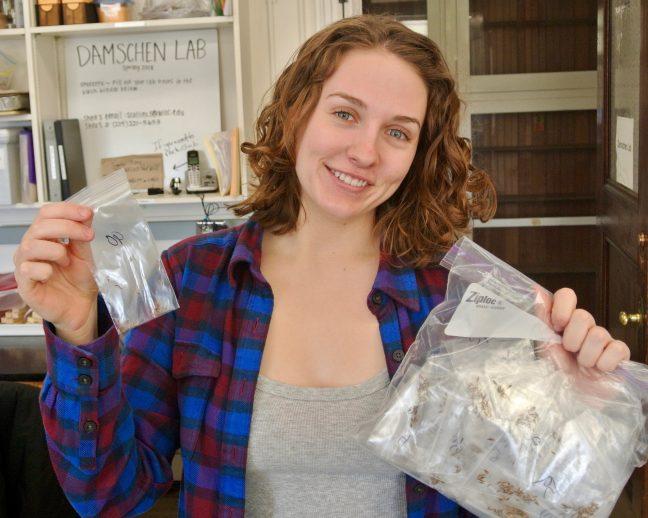Every week, The Lab Report will feature a different undergraduate-research assistant on campus and their experience in the lab.
Ellen Damschen Lab, Department of Integrative Biology
Human-induced changes and normal environmental processes are disrupting the cohesion of Wisconsin’s tallgrass prairies at an increasingly fast pace.
To protect the organisms that depend on tallgrass prairies, it’s important to restore and maintain these ecosystems, University of Wisconsin junior biology student Genevieve Anderegg said.
“Prairies are becoming rare in Wisconsin, even though they used to cover this region,” Anderegg said. “It’s important to have prairies because it’s what is supposed to be there.”
Wisconsin’s tallgrass prairies are a source of plant diversity, which is the foundation supporting a wide range of animals through a complex, interconnected system.
Primary consumers like insects feed on the vegetation and in turn, large predators feed on them. Other predators consume these predators and this self-regulating cycle continues.
“[The system is] like a puzzle,” Anderegg said. “If you take out one part, it’s going to mess everything up.”
Anderegg is conducting undergraduate research in professor Ellen Damschen’s lab. Her research seeks to aid prairie conservationists and identifies the practices that are most beneficial to promote and maintain species diversity in these grasslands.
Anderegg’s project specifically investigates how dead plant material and snow cover in prairies affect small mammals, who use both to avoid becoming prey while foraging for seeds.
These seed predators are important members of the community because they influence plant community development and structure, she said.
“Small mammals can restrict growth of some species by feeding on their seeds, but they can help disperse other species by collecting their seeds and storing them,” Anderegg said.
Understanding how seed foragers’ activities change in the presence of varying levels of snow cover and plant litter, which is dead plant material, is important to inform prairie conservation efforts, especially approaches to controlled burning, she said.
Controlled burning is an important strategy to maintain plant diversity, Anderegg said. It restores nutrients that will lead to more desirable plant growth in the future.
The time of the season when prairies are burned affects the amount of plant litter present in the winter, she said. The earlier in the season the prairie is burned, the more dead plant matter accumulates and covers the ground in the winter months.
As snow cover decreases in response to climate change, the ideal amount of cover from dead plant matter may change and management strategies might need to be modified to accommodate this, Anderegg said.
Anderegg uses several plots of land to replicate conditions with different levels of snowfall and plant litter for her study. Each of these plots will contain a number of “seed containers.”
The seed containers protect their seeds from the elements while allowing small mammals to freely access them. Each container holds several seeds mixed into sand to mimic their natural occurrence. Anderegg will record the amount and weight of seeds in each seed container before and after the study.
Anderegg hopes to learn how levels of seed predation change under different litter and snow conditions, which will affect future plant prairie communities and restoration trajectories.
Anderegg’s research is being conducted alongside a larger prairie climate change experiment her mentor Jon Henn, a UW graduate student in the department of integrative biology, conducts.
Henn uses the same treatment plots as Anderegg to investigate the effect of winter climate change on prairie plant communities. He examines the effect of variable soil temperature resulting from an absence of insulating snow cover on seed establishment.
“Genevieve’s question is interesting on its own but is also helpful to the overall project goal,” Henn said. “We want to be able to quantify the effect of small animals eating the seeds we’re putting out. Then we can account for that when looking at our climate manipulations.”
Anderegg is passionate about her research and loves that it gives her the opportunity to make a positive impact on the world outside of the university.
She hopes her findings can help those who are trying to sustain our environment.
“We know climate is changing” Anderegg said. “The way conservationists manage their land could really impact the way things change going forward. Our goal is to make concrete recommendations about how to maintain the prairie that you want while the climate continues to change.”



